
The Arrow | Cuper's Cove | The Island | Johnny August | Nancy April | Shanaditti
 The Arrow | Cuper's Cove | The Island | Johnny August | Nancy April | Shanaditti |
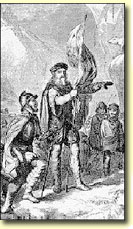 |
Five o’clock in the morning—June 27th, 1497. That was the time recorded when the Venetian John Cabot and his son Sebastien first discovered the island. |
How and why so little real effort was made to prevent this tragedy from occurring is difficult to grasp. That a government could never let its concern for the plight of these people go beyond an investigative committee or the issuing of infrequent Royal Proclamations forbidding the practice of cruelties to this race, was, in the final analysis, the greatest injustice to be dealt to that unfortunate tribe. To be sure, there were those certain individuals, honorable, and with the highest regard for humanity, who cried out against the terrible injustices which were heaped upon the Red people of Newfoundland. Their loud cry for an end to the pitiful circumstances warned also of the inevitable end result should compassion and justice not prevail. These people were true heroes of the Beothuk cause – but too few and too late. The last known Beothuk died in captivity in St. John’s Newfoundland on June 6th, 1829.Pathetically little was learned about this strange and unique people from the time of Cabot’s discovery to the present day. And yet, because of their wretched existence dealt by the hand of the settlers and explorers; because of the great debt that is owing them, we must view what little knowledge we have of them as precious, and seek to build on that knowledge. We must not continue to bury them in the past to avoid feelings of guilt and embarrassment. The island was their home. Long before the coming of the ships – the island was their home. It heard their songs, their stories and their prayers. It drank of their tears – and their blood. It now holds within its breast their remains, and perhaps many secrets that in time will help us to unravel their mystery, to know them and to understand them better. |
| The Arrow |
Information gleaned from 16th century historical documentation e.g. letters of Venetian Ambassador Pietro Pasqualigo & Kerr’s Travels, Vol. VI, shows that in the 1500’s the cruel disrespect shown by many settlers and explorers toward the native Newfoundland Indians was apparent even from their earliest meetings. These conditions were destined to continue and worsen for the Beothuks with the passage of time. During an expedition in 1612, Governor John Guy succeeded in establishing friendly relations with the Beothuks, an event that may be regarded as a crucial meeting between the settlers and the natives. The meeting was described in John Guy’s Narrative of 1612. |
| Cuper’s Cove |
| The next year, at the appointed time, there came instead another ship. The master of that ship, seeing so many natives assembled on the shore, and having no knowledge of the arrangement that had been made between Guy and the Beothuks, assumed an attack was imminent and fired a charge amongst them from his cannon. The natives scattered dumbfounded and terrified into the forest. Some believe that from that day forward, owing to the supposed treachery, the Red Indians of Newfoundland would forever refrain from any contact with the white settlers. |
The Island |
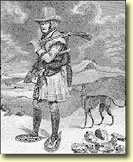 |
Major John Cartwright was a true champion of the cause to help the Beothuk people. Through his journey up the Exploits river into the interior of the island in 1768, he gained a great deal of knowledge about the tribe. He made valiant efforts to open friendly relations with the Red Indians, and was also instrumental in sounding the alarm regarding the desperate consequences that would be faced by this tribe should conditions not change. |
Wrote John Cartwright: |
| “The Red Indians have no contact with the Europeans except a hostile one, which that uncivilized people have great reason to think is founded upon a just and noble resentment of wrongs. On the part of the English fishers it is an inhumanity which sinks them far below the level of savages. The wantonness of their cruelties against the poor wretches has frequently been almost incredible. One well known fact shall serve as an example. A small family of Indians, being surprised in their wigwam by a party of fishermen, all fled, to avoid if possible, the instant death that threatened them from the fire arms of their enemies. One woman, being unable to make her escape, yielded herself into their power. Seeing before her none but men she might naturally have expected that her sex alone might have disarmed their cruelty, but to awaken in them still stronger motives to compassion, she pointed with an air of most moving entreaty to her prominent belly. Could all nature have produced another pleader of such eloquence as the infant there concealed? But this appeal, oh shame to humanity, was alas, in vain: for an instant stab that ripped open her womb, laid her at the feet of those cowardly ruffians, where she expired in great agonies. Their brutal fury died not with its unhappy victim, for with impious hands they mutilated the dead body so as to become a spectacle of the greatest horror. And that no aggravation of their crime might be wanting, they made at their return home their boasts of this exploit. Charity might even have prevailed in their favor, against their own report, and have construed their story into a lie which in reality they were incapable of committing, had they not produced the hands of the murdered woman, which they displayed on the occasion as a trophy. I meant to confine myself to a single proof of my charge against the fishermen, yet, as that is general and of so criminal a nature, it may not be amiss to bring more evidence against them in order to satisfy that the guilt has not been exaggerated. The following story will but too much confirm what has already been advanced. Some fishermen, as they doubled in their boat a point of land, discovered a single, defenseless woman with an infant on her shoulders. One of them instantly discharged at her a heavy load of swanshot, lodging it in her loins. Unable now to sustain her burden, she unwillingly put it down, and with difficulty crawled into the woods holding her hand upon the mortal wound she had received, and without once taking her eyes off the helpless object she had left behind her. In this dreadful situation she beheld her child ravished from her by her murderers, who carried it off to their boat. How the infants cries as they bore it off must have pierced her fainting heart.” |
Johnny August |
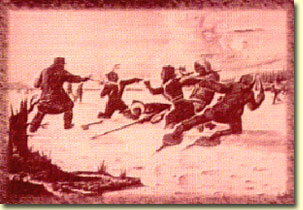 |
In the early 19th century it finally began to dawn on government officials that total eradication of this race was a certainty if drastic measures were not put into effect. There was far greater emphasis given to the absolute necessity of opening some kind of communication with the Beothuk community, by friendly means, and large rewards were offered to anyone able to achieve this end. Justice of the Peace John Peyton Senior was a successful fisherman / fur trader in the Bay of Exploits, who led the fateful expedition that captured the Beothuk princess Demasduit, better known as Mary March, in the year 1819. In this undertaking he also contributed to the death by shooting and stabbing of the Indian Chief Nonosbawsut. A letter to the editor of the Liverpool Mercury, giving a description of the events of that unfortunate confrontation, was sent by an anonymous correspondent, who claimed to have been a member of the Peyton expedition. After serious examination the letter bears every evidence of being reliable. |
The Letter |
| About three o’clock in the afternoon two men, who then led the party, were about two hundred yards ahead of the rest. Three deer, followed closely by a pack of wolves, issued from the woods to the left and bounded across the lake, passing very near the men, whom they totally disregarded. The two men incautiously fired at them. We were then about half a mile from the point of land that almost intersected the lake, and in a few moments we saw it covered with Indians who instantly ran off. The alarm was given. We soon reached the point and about five hundred yards on the other side we saw the Indian’s houses and the Indians, men, women and children, rushing from them across the lake. Hurrying on we quickly came to the houses, when within a short distance from the last house, three men and a woman with a child issued forth. One of the men took the infant from her and their speed soon convinced us of the futility of pursuit. The woman however, did not run so fast. Mr. Peyton loosened his provision bag from his back and let it fall; threw away his gun and hatchet and set off at a good speed that soon overtook the woman. One man and myself did the same, except our guns. The rest, picking up our things, followed. On overtaking the woman she instantly fell on her knees, and tearing open her dress, showing her breasts to prove she was a woman, she begged for mercy. In a few moments we were by Mr. Peyton’s side. Several of the Indians, with the three who had quitted the house with the woman, now advanced while we retreated towards the shore. At length we stopped, and they did the same. After a pause, three of them laid down their bows and came within two hundred yards. We then presented our guns, intimating that not more than one would be allowed to approach. They retired, and fetched their arms, when one, the ill-fated husband of our captive Mary March advanced with the branch of a spruce tree in his hand. When about ten yards off he stopped and made a loud speech. Towards the last, his gesture became very animated, and his eyes shot fire. He concluded very mildly, and advanced, shaking hands with many of the party – then he attempted to take his wife from us. Being opposed in this he drew an axe from beneath his Cossack, finely polished, and brandished it over our heads. On two or three muskets being presented, he gave up the axe to Mr. Peyton, who then intimated that the woman must go with us, but that he might go too if he pleased, and that in the morning both should have their liberty. At the same time two of the men began to conduct her towards the houses. On this being done he became infuriated, and rushing towards them, strove to drag her from them. One of the men rushed forward and stabbed him in the back with a bayonet. Turning around, with a blow he laid the fellow at his feet. The next instant he knocked down another, and rushing on, like a child he laid him on his back, and seizing his knife from his belt, brandished it over his head. The next instant it would have been buried in him had I not with both hands seized his arm. He shook me off in an instant while I measured my length on the ice. Mr. Peyton then drew a pistol from his girdle and fired. The poor wretch first staggered then fell on his face. While writhing in agonies he seemed for a moment to stop, his muscles stiffened. Slowly and gradually he raised himself from the ice, turned around, and with a wild gaze, surveyed us all in a circle around him. His eyes, flashing fire, yet with the glaze of death upon them, they fixed on the individual who had first stabbed him. Slowly he raised the hand that still held the dagger, when uttering a yell that made the woods echo, he rushed at him. The man fired as he advanced and the noble Indian again fell on his face. A few moments struggle and he lay a stiffened corpse upon the icy surface of the limpid waters. For my part I could scarcely credit my senses as I beheld the remains of the noble fellow stretched on the ice, crimsoned with his already frozen blood. One of the men went to shore for some spruce boughs to cover the body, which measured as it lay 6 feet 7 ½ inches. The woman at first seemed scarcely to notice the corpse, and it was not until we were obliged to leave the remains of her husband that she gave way to grief and vented her sorrow in the most heartbreaking lamentations. |
Captain David Buchan figures prominently in the history of Newfoundland, especially in attempts to open up communication with the Beothuks. He was a highly decorated, and much admired man from all quarters. His most memorable expeditions relative to creating friendly relations with the Beothuk Tribe were to Red Indian Lake in 1810 – 11, and again in 1820. |
| The first excursion was beneficial in terms of estimating their condition and number, as well as a wealth of particulars about tools and living habits. His second trip, in 1820, was to deliver the captive, Mary March, back to her tribe.In captivity it was recognized that Mary’s power of mimicry was very remarkable and enabled her to quickly speak the language that she heard. She remained only a short time in St. John’s, but acquired such facility in speaking English that hopes of opening a communication with the Red tribe, through her means, was entertained. Captain Buchan was dispatched to the Exploits River, along with the captive Mary March to make such an attempt, and it was much hoped that this would put an end to the sufferings of the remaining Beothuks. But it was not to be. Whatever it was that operated on natives separated from their natural environment, did not spare poor Mary March. She left St. John’s with a bad cough and died of consumption on nearing the Exploits, aged 24. Captain Buchan, after a laborious journey, reached the wigwams but found them empty, and deposited there the coffin of Mary March, with her presents, dresses and moccasins. |
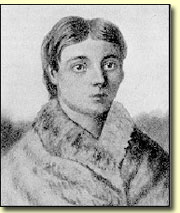 |
Nancy April |
A letter from Administrator R.A. Tucker to the Newfoundland Government, dated June 29th, 1825. A good description of that last known Beothuk, the captive Shanaditti, or Nancy April, comes to us through information provided by a man named John Gill, whose mother was a servant of John Peyton and worked beside Nancy April. Nancy was very pert at times, and openly defied Mrs. Peyton when the old woman was cross with the servants. Nance would laugh in her face and say, “ Well done Missus, I like to hear you jaw, that right” or “ jawing again Missus ?” |
OBITUARY DIED – at St. John’s Newfoundland on the 6th of June last, in the 29th year of her age, Shanaditti, supposed to be the last of the Red Indians or Beothuks. This interesting female lived six years a captive amongst the English, and when taken notice of, latterly exhibited extraordinary mental talents. She was niece to Mary March’s husband, who was accidentally killed in 1819 at Red Indian Lake in the interior, while endeavoring to rescue his wife from the party of English who took her, the view being to open a friendly intercourse with the tribe. |
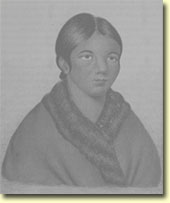 |
Shanaditti |
William E. Cormack perhaps represented the last fading hope of the Beothuk people. It was he who formed the Society called the Beothuk Institution, for the purpose of opening a communication with, and promoting the civilization of the Red Indians of Newfoundland. Cormack wrote in 1829: |
Home |